As a young child, I remember spending a lot of my free time outdoors. We didn’t have computers or video games back then to steal our attention. My siblings, my friends, and I would spend many a leisurely day out in the fresh air exploring, climbing trees, riding our bicycles, fishing, playing baseball, and just being kids. We got plenty dirty in the process, which we never really seemed to mind!
It was a much simpler time, and one that many children today will sadly never experience. Even if they’re able to overcome the allure of technological distractions, our young people today face an escalating onslaught of environmental pollution every time they venture outside.
Many of our most precious shared natural resources are taking a major hit thanks to the “better living through chemistry” credo of modern-day living that – despite making our everyday lives more convenient – has rendered many of the outdoor environments where our children play unfit for use.
Even the one place where our kids have yet to be drawn away by the siren’s song of smartphones and Snapchat – the sports field – has become a potential health hazard. Those heavily manicured grass fields and advanced artificial turfs where our children show off their athletic abilities are often minefields of weed killer chemicals, synthetic fertilizers, and other potentially toxic substances… some of which have been linked to causing cancer.
Many parents don’t even think twice about the possible health risks involved when it comes to letting their kids play outdoor sports, because the health hazards are hidden amidst all that enticing greenery. My children are getting exercise while playing their favorite sports on plush, green grass and there’s nothing to worry about is the thought process.
In an ideal world, this would be all there is to it… but sadly, things just aren’t that simple anymore.
Why That Perfect-Looking Grass is Not-So-Perfect for Your Health
Believe it or not, grass typically doesn’t grow in absolute uniformity like you see it on soccer fields and in public parks without constant tending, and I’m not just talking about manual weeding.
Unless you live in an area of the world where native grasslands are rich and dense, chances are those luscious blades you see are being helped along with generous helpings of chemical fertilizers, pesticides, herbicides, and possibly even green spray paint, depending on the climate and time of year.
According to a report by Beyond Pesticides, the average playing field is doused with not just one or two, but three, four, or even five types of herbicides, fungicides, and insecticides intended to keep invasive pests and plant species at bay.
Many of these chemicals are known to trigger asthmatic symptoms, inhibit proper childhood development, and even cause cancer – but at least they’ll keep those broadleaf weeds or dandelions from getting in the way of the ball, right?
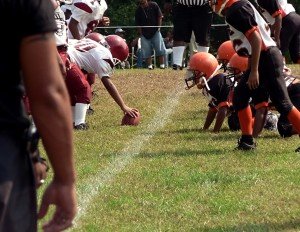
The typical sports playing field is doused with numerous chemicals that players are exposed to and then bring home on their skin, clothing, and equipment
In all seriousness, these highly toxic poisons are getting all over our children as they run down the field, tackle other players, and handle the ball; not to mention all the residue they track into the house after practice or a big game.
The Beyond Pesticides report lists the following chemicals as being among those that are widely used on “natural” grass playing fields:
- Trimec
This three-in-one selective herbicide contains the following three chemicals, the individual safety profiles for which I’ll outline below: Mecoprop, Dicamba, and 2,4-D. Trimec is used to keep dandelion, plantain, chickweed, clover, wild onion, and various other “weeds” from growing within grass. It’s said to be safe when used in accordance with the instructions, but the actual facts speak louder than this empty marketing claim.
- Mecoprop
One of three primary ingredients in Trimec, Mecoprop is an extremely toxic herbicide chemical that’s very easily absorbed through the skin. It mimics the naturally-occurring plant hormone indole-3-acetic acid (IAA), making it an endocrine-disrupting chemical (EDC) that also interferes with human hormone expression.
- Dicamba
The second of the three chemicals in Trimec, Dicamba is a developmental toxin. In addition to being an EDC like Mecoprop, it has also been shown to damage DNA. Residues of Dicamba in soil and on plants are highly persistent due to the chemical’s extreme mobility, making it a serious threat to sports players that encounter it during practice or games.
- 2,4-D (Dichlorophenoxyacetic acid)
This post-emergent herbicide was a major component of the deadly defoliant Agent Orange used during the Vietnam War, but it also happens to kill crab grass and dandelion seed.
The Natural Resources Defense Council (NRDC) says 2,4-D is “the most dangerous pesticide you’ve never heard of,” despite having been considered “clean and green” for many years. 2,4-D is linked to causing non-Hodgkin’s lymphoma (a type of blood cancer) and sarcoma (a soft-tissue cancer). The International Agency for Research on Cancer (IARC), a division of the World Health Organization (WHO), recently dubbed it a “possible human carcinogen” – a big admission for this usually non-forthcoming United Nations agency.
2,4-D is also a known endocrine-disrupting chemical (EDC), which means it impedes the normal action of androgen (an important male hormone), estrogen (an important female hormone), and thyroid hormones, thereby disrupting normal human development.
- Roundup (glyphosate)
The world’s most popular weed killer, Roundup, is a product of Monsanto. It is also arguably the most pervasively damaging weed killer in the world. Numerous studies have linked it to cell damage as well as genetic malformations, birth defects, dementia, autism, celiac disease, chronic kidney disease, diabetes, heart disease, hypothyroidism, inflammatory bowel disease, multiple sclerosis, and many different types of cancer.
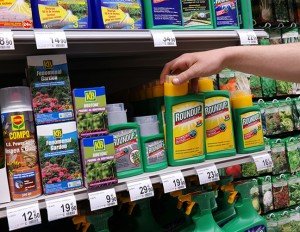
Roundup is the world’s most popular weed killer and is linked with a wide range of diseases, including cancer
Like with 2,4-D, the WHO now admits that Roundup “probably” causes cancer. And secondary research suggests that at least one of the “inert” ingredients in oundup, polyethoxylated tallowamine (POEA), is hazardous to embryonic, placental, and umbilical cord cells – perhaps even more so than the herbicide itself.
These are just a few of the many different chemicals used on playing fields that the Environmental Protection Agency (EPA), the National Academy of Sciences (NAS), the American Public Health Association (APHP), and many other prominent government agencies admit are a threat to our children’s neurological, respiratory, immune, and endocrine systems – even at very low levels!
If you find this to be deeply concerning, you’re not alone. So do I and so do many others! There’s just too much at stake to subject our children to these deadly, noxious compounds that could cause them a lifetime of pain and suffering, not to mention contract a potentially irreversible chronic disease. Heck, even as adults we shouldn’t have to expose ourselves to these and other poisons every time we shoot a round of 18 holes or go play a pickup game of flag football.
So what’s the solution…?
Heavy Metals and Chemical Carcinogens in Synthetic Turf
If your first thought in response to this question was synthetic grass, or artificial turf, think again. Fake grass is perhaps more of a threat, or at the very least equally as menacing as chemical-treated turf, and for much the same reason. The only way to produce a material that resembles the look, feel, and color of real grass without actually being grass is to combine hordes of chemical compounds – and this is exactly what’s being done.
From the early days of the 1960s when it was first introduced up until today, synthetic turf has long been a controversial subject. On the one hand, it provides a level of convenience that natural grass doesn’t. For instance, synthetic turf doesn’t need to be watered in order to keep it green, and it can be used year-round with little to no daily maintenance. On the other hand, it has a questionable safety profile and is now under scrutiny for possibly causing cancer.
Believe it or not, a team of scientists from Monsanto originally developed what was known as “ChemGrass” – a synthetic fiber material made from nylon and polypropylene plastic that the Houston Astros baseball team decided to install at the AstroDome. This is why ChemGrass was later given the nickname “AstroTurf.”
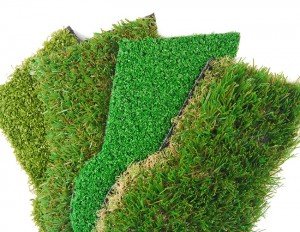
AstroTurf was originally known as “ChemGrass,” a much more accurate name as it contains 96 chemicals – many of which are carcinogens
A crudely-matted carpeting of green plastic threads layered over a base of concrete, AstroTurf allowed players to trample all over the field without killing the “grass.” This was enough to send AstroTurf soaring into widespread use all across the country. Newer, more realistic, versions of AstroTurf would later be developed, with today’s varieties containing a complex blend of plastic, rubber, and other extruded materials that more closely resemble the look and feel of real grass.
A supposedly “bio-friendly” turf mixture containing recycled tire rubber is probably the most common form of AstroTurf used today. But a professor from Yale University who recently conducted an analysis on various turf samples identified an astounding 96 different chemicals within them, some of which are carcinogenic.
Toxic substances such as benzene, mercury, arsenic, and lead were among the chemicals found in the various samples of artificial turf. And because the tire recycling process involves blending together all sorts of different scrap tires from all over the place into tiny turf fibers and crumb rubber, it’s a guessing game trying to figure out which playing fields contain which chemicals. For all we know, most fields contain most or even all of these chemicals.
Just think for a moment about tire rubber and all that it encounters when moving along the road. Motor oil, antifreeze, environmental runoff, pollution from exhaust, and anything else that might leak from a car or fall from the sky ends up getting mixed in during processing and poured onto our children’s playing fields. Kind of a scary thought, wouldn’t you say?
Artificial Turf & Cancer Risk
Reports are now surfacing of elevated cancer rates among soccer players – and particularly soccer goalies – who regularly encounter this tainted crumb rubber on synthetic turf. University of Washington associate soccer coach for women, Amy Griffin, is just one observer among many who’s noticed a trend among players exposed to the tiny, sometimes dust-like, rubber pellets.
Griffin told the Los Angeles Times during a 2016 interview that many of her fellow players over the years have developed lymphoma. The common thread among all of them is that they’ve all come into direct contact with the crumb rubber. Whether via skin contact, inhalation, or accidental ingestion, the volatile organic compounds in crumb rubber seem to be making their way into players’ bodies during games.
The National Center for Health Research, Environment and Human Health, Inc. and various other groups likewise affirm that artificial turf containing crumb rubber is problematic. They point to research showing that cancer rates among athletes who regularly play on it are significantly higher than they are for everyone else. Loose crumb rubber is also routinely used in playgrounds as well as in the soft tiles used to cover walkways and play surfaces in public parks – all areas most frequented by young children.
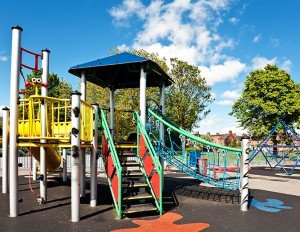
Crumb rubber is often used to protect children from falls in playgrounds. However, it contains deadly chemicals that have been linked to childhood cancer
Compared to natural wood chips, this rubber is orders of magnitude more toxic, according to the California Office of Environmental Health Hazard Assessment (OEHHA). They have identified a host of deadly chemicals in its own tests on crumb rubber, including chrysene, a polycyclic aromatic hydrocarbon (PAH), that’s been scientifically linked to causing childhood cancer.
Organic Playing Fields? They’re Not as Impossible as You Might Think
But natural grass is too much work, and it’s not even possible to grow it organically anyway, right? Wrong!
Chip Osborne, a horticulturalist from Marblehead, Massachusetts, says it’s not only possible but absolutely prudent to grow real grass organically on playing fields – not only for the environment’s sake but also for the sake of our children. Osborne successfully transformed a 15-acre conventional playing field in his hometown to an organic one, and it’s now routinely used by local sports teams without any problems.
Offering fresh insight to Beyond Pesticides, Osborne also dispelled several prominent myths about organic turf management that have kept many school districts from adopting it – mainly that going truly “green” will make playing fields more prone to disease, weeds, pests, and player injury, and that ultimately it’s too costly.
Not only is a properly installed and maintained organic field less prone to weeds and pests than a conventional one, it’s also cheaper. By incorporating beneficial microorganisms into the soil and covering this soil with an appropriate top dressing of organic compost, diseases, pests, and weeds simply won’t have a chance to take hold, he says.
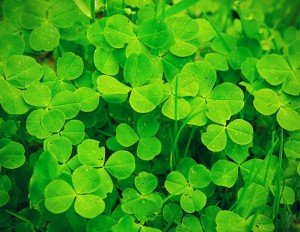
Clover can actually be beneficial to turf as it draws nitrogen from the air into the soil, tolerates compacted soil better than grass, and has deeper roots to access water
Balancing pH levels in the soil and making sure that enough nitrogen is present will also help to ensure that pervasive “weeds” like clover don’t take over. In fact, clover is actually beneficial to turf when present at a reasonable tolerance level, and can be used in conjunction with proper aeration, natural fertilization, and watering to attain a perfect balance.
“Ecological turf maintenance calls for the manager to consider all of the organisms in the turf ecosystem because most of them are allies,” explains Paul Sachs in his book Managing Healthy Sports Fields: a guide to using organic materials for low-maintenance and chemical-free playing fields. “It also means expectations may have to be adjusted to a more realistic and practical threshold where a natural equilibrium can be maintained.”
This is helpful advice if you’re a turf manager, but what can you do as a parent to make an impact?
Protecting Your Kids & Grandkids: What Can You Do?
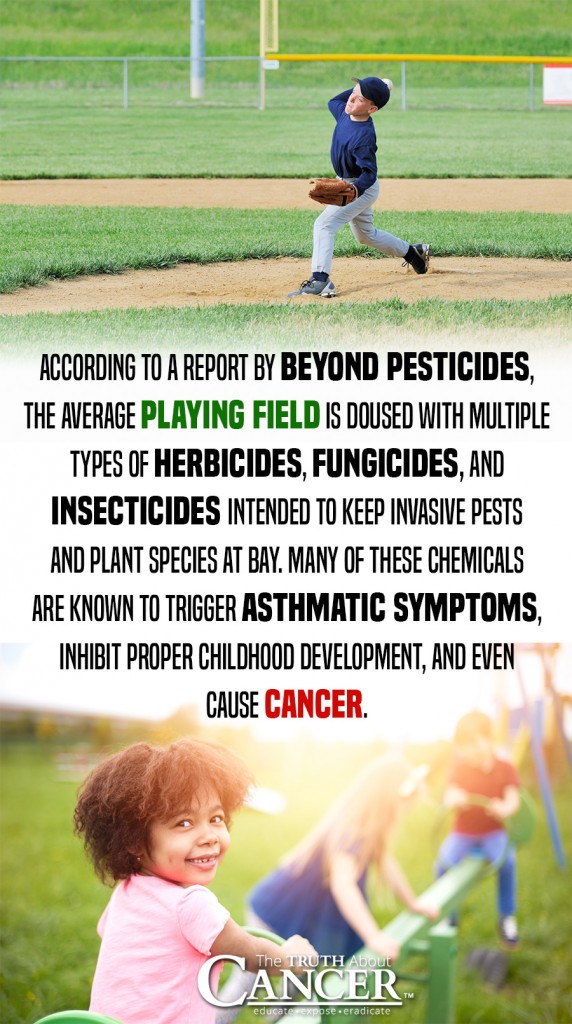
While you’re at it, you can also give your city administrators and your parks and recreation department a call. Encourage them to reconsider turf management at your local public parks and playing fields, which are frequented by both young and old people, as well as pets – all of whom are at risk from chemical exposure.
Truth be told, some 33 states and more than 400 school districts throughout the U.S. currently have laws and/or policies in place that restrict the use of chemicals that unnecessarily put children at risk. And based on the fact that organic turf is cheaper than non-organic turf and much easier to maintain (if properly managed), the continued use of conventional and synthetic turf at your local schools and parks might just fall into the unnecessary category from a legal perspective.
Here are some helpful tips for how to approach local authorities and school officials about this important issue:
- Find out whether your state, school, or local community has laws and/or policies on the books governing pesticide use in and around school grounds, and/or on public lands. If such laws and/or policies exist, research how well they’re being implemented and get to work on improving enforcement.
Encourage the officials who control field management to make the switch to organic turf fields
- If such laws and/or policies don’t exist, start petitioning for an organic land care policy to be implemented.
- Contact your local school district and parks department and encourage whoever handles such matters to convert all playing fields to organic management.
- Petition for the grounds maintenance director or whoever handles land management care in your area to be properly trained in organic practices.
The City of San Francisco developed its own ecologically-friendly Integrated Pest Management (IPM) program that utilizes multiple different methods of controlling weeds and growing grass safely without the need for pesticides or tainted rubber. This is a great place to start when conversing with local officials about implementing a similar model in your own area.

Reduce chemical exposure by keeping sports gear out of the house and washing uniforms (and kids) as soon as they get home from the field
If your children are already playing on conventional or synthetic turf fields, you can help minimize their exposure to toxic chemicals by making sure they take their shoes and gear off before entering the house after practice and games. Immediately put all their clothes and washable gear into the washing machine and have them promptly sanitize their hands and take a shower.
You can also avoid using any “weed and feed” products on your home lawn and encourage your neighbors to do the same. The less exposure to chemicals the better, and it all starts in the home.
Want to stay abreast of new ways to stay healthy? Be notified each week when cutting-edge articles are added by clicking here. You’ll be glad you did.
Article Summary
Heavily manicured grass fields and advanced artificial turfs where children play are often minefields of weed killer chemicals, synthetic fertilizers, and other potentially toxic substances.
The average playing field is doused with up to 5 types of herbicides, fungicides, and insecticides.
Many of these chemicals are known to trigger asthmatic symptoms, inhibit proper childhood development, and even cause cancer.
AstroTurf was originally known as “ChemGrass,” a much more accurate name as it contains 96 chemicals – many of which are carcinogens.
Research shows that cancer rates among athletes who regularly play on artificial turf are significantly higher than they are for everyone else.
If your children are playing on conventional or synthetic turf fields, minimize exposure to toxic chemicals by taking off their shoes and gear before entering the house after practice and games.










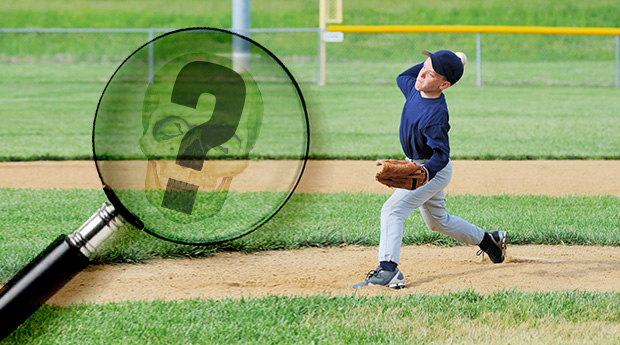









We live in a very toxic world. When children and adults go outside to play in the sports field and playground, we just do not know how much poison that we are putting inside our system. We assume going in the outdoors is good for our health, but we never think about it giving us cancer. It is not too surprising why babies, children, teenagers, young adults, and middle-aged adults are getting cancer so young with all the poisons that we are exposed to.
I’m still confused as to how to have a nice looking lawn without using any chemicals.